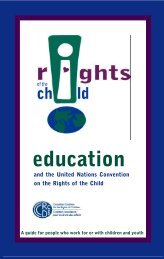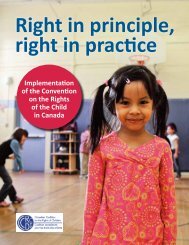Poste - Canadian Coalition for the Rights of Children
Poste - Canadian Coalition for the Rights of Children
Poste - Canadian Coalition for the Rights of Children
You also want an ePaper? Increase the reach of your titles
YUMPU automatically turns print PDFs into web optimized ePapers that Google loves.
C A N A D I A N C O A L I T I O N F O R T H E R I G H T S O F C H I L D R E N<br />
Guidelines: Processing Claims <strong>of</strong> Unaccompanied <strong>Children</strong><br />
The fact that children claiming refugee status can be unaccompanied raises many unique concerns with respect to <strong>the</strong><br />
processing <strong>of</strong> <strong>the</strong>ir claims...<br />
1. Claims <strong>of</strong> unaccompanied children should be identified as soon as possible....<br />
2. The Convention Refugee Determination Division (CRDD) and Refugee Claim Officer (RCO) should be immediately<br />
assigned to <strong>the</strong> claim and, to <strong>the</strong> extent possible, <strong>the</strong> same individuals should retain responsibility <strong>for</strong> <strong>the</strong> claim until<br />
completion. It may also be necessary in some cases to assign an interpreter to <strong>the</strong> claim as early as possible so that<br />
<strong>the</strong> child can develop a relationship <strong>of</strong> trust with <strong>the</strong> interpreter. Be<strong>for</strong>e <strong>the</strong> panel, RCO and interpreter are<br />
assigned, consideration should be given to <strong>the</strong>ir experience in dealing with <strong>the</strong> claims <strong>of</strong> children.<br />
3. The claim should be given scheduling and processing priority because it is generally in <strong>the</strong> best interests <strong>of</strong> <strong>the</strong> child<br />
to have <strong>the</strong> claim processed as expeditiously as possible. There may be circumstances, however, where in <strong>the</strong> best<br />
interests <strong>of</strong> <strong>the</strong> child <strong>the</strong> claim should be delayed...<br />
4. A designated representative <strong>for</strong> <strong>the</strong> child should be appointed as soon as possible following <strong>the</strong> assignment <strong>of</strong> <strong>the</strong><br />
panel to <strong>the</strong> claim...<br />
5. A pre-hearing conference should be scheduled within 30 days <strong>of</strong> receipt <strong>of</strong> <strong>the</strong> Personal In<strong>for</strong>mation Form....<br />
6. In determining what evidence <strong>the</strong> child is able to provide and <strong>the</strong> best way to elicit this evidence, <strong>the</strong> panel should<br />
consider, in addition to any o<strong>the</strong>r relevant factors, <strong>the</strong> following: <strong>the</strong> age and mental development <strong>of</strong> <strong>the</strong> child both<br />
at <strong>the</strong> time <strong>of</strong> <strong>the</strong> hearing and at <strong>the</strong> time <strong>of</strong> <strong>the</strong> events about which <strong>the</strong>y might have in<strong>for</strong>mation; <strong>the</strong> capacity <strong>of</strong><br />
<strong>the</strong> child to recall past events and <strong>the</strong> time that has elapsed since <strong>the</strong> events; and <strong>the</strong> capacity <strong>of</strong> <strong>the</strong> child to<br />
communicate his or her experiences. 28<br />
Guidelines: Eliciting <strong>the</strong> Evidence<br />
Whe<strong>the</strong>r accompanied or unaccompanied, a child claimant may be called upon to provide evidence through oral<br />
testimony about his or her claim... In general, children are not able to present evidence with <strong>the</strong> same degree <strong>of</strong><br />
precision as adults with respect to context, timing, importance and details.... In addition, children may manifest <strong>the</strong>ir<br />
fears differently from adults.<br />
1. The process which is to be followed should be explained to <strong>the</strong> child throughout <strong>the</strong> hearing to <strong>the</strong> extent possible,<br />
taking into account <strong>the</strong> age <strong>of</strong> <strong>the</strong> child. In particular, <strong>the</strong> various participants and <strong>the</strong>ir roles at <strong>the</strong> hearing should<br />
be explained as well as <strong>the</strong> purpose <strong>of</strong> questioning <strong>the</strong> child and <strong>the</strong> sequence <strong>of</strong> questioning...<br />
2. Be<strong>for</strong>e hearing testimony from a child, <strong>the</strong> panel should determine if <strong>the</strong> child understands <strong>the</strong> nature <strong>of</strong> an oath or<br />
affirmation to tell <strong>the</strong> truth and if <strong>the</strong> child is able to communicate evidence. If <strong>the</strong> child satisfies both <strong>of</strong> <strong>the</strong>se<br />
criteria <strong>the</strong>n he or she can take an oath or solemn affirmation. A child who does not satisfy <strong>the</strong>se criteria can still<br />
provide unsworn testimony. The weight to be given to <strong>the</strong> unsworn testimony depends on <strong>the</strong> child’s understanding<br />
<strong>of</strong> <strong>the</strong> obligation and his or her ability to communicate evidence.<br />
3. The environment in which <strong>the</strong> child testifies should be in<strong>for</strong>mal. It may be appropriate to use an interview-style<br />
room ra<strong>the</strong>r than a hearing room. It may also be appropriate to have an adult whom <strong>the</strong> child trusts present when<br />
<strong>the</strong> child is providing in<strong>for</strong>mation about his or her claim.<br />
104




